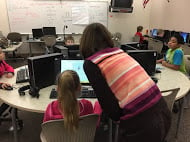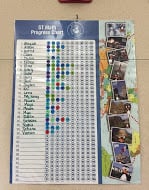
By: Ellen Dorr
As students work on ST Math in Carol DeSilva’s 3rd grade classroom at North Hill Elementary in Highline Public Schools, most are quietly focused, some count on their fingers, some write in notebooks, a few help classmates near them, and more than once, an excited student exclaims, “YES, 100%! Again!”

In Highline, we’ve used ST Math for 4 years to support student learning needs around mastery of mathematical standards. This tool is ideal for our K-3 students because it is language-independent, engaging, aligned to standards, and motivating.
Using the right tool for the job is critical. A powerful digital tool can accelerate student achievement. In Highline Public Schools, we evaluate our digital tools by collecting data from the tool (time in the tool and completion of number of lessons or progress of standards mastery) and from external sources (lexile or quantile data on benchmark assessments) and by looking for strong correlations. We know that the right tool will improve student learning outcomes so we examine the student outcomes we see with our tools. We institutionalize tools that deliver. We move away from those that don’t.
Additionally, we know that the level of impact depends on implementation of the tool.
As a district, our priorities are to support use of tools instructionally, meaning we will help to refine best practice around the tool by identifying target students, ideal implementation models, and how the tool integrates with existing instructional practice.
Our initial use of ST Math helped us to learn how to improve our use of the program in the blended classroom. We knew from our use of other tools that teachers needed to confer with students about their learning and map that learning back to classroom instruction. We posted sentence stems and began conversations with students as they helped JiJi continue the quest. We looked for hurdles and began to address those with students.

We learned that monitoring students use of the program was a critical first step. We began publicly tracking data and monitoring progress with posters and stickers. We saw results and realized that how we supported students in using ST Math amplified its power as a tool. We created a professional development plan around using ST Math which included support from our STEM coaches around how to read reports and support struggling students and sharing of video of great teaching practices in using the tool.
One of those videos featured Ms. DeSilva. In her class, student learning is accelerated by ST Math because of the high-impact educational practices she uses support its use.
DeSilva does several things to enhance the power of ST Math:
Every Monday, she prints out ST Math reports and analyzes what she’s seeing. She knows when a student had low time-on-task because they were interrupted and when they were stuck. She pulls groups of students with similar struggles, works via ST Math's teacher mode feature (which allows playback of student play) with them, and then sends them back to independent work.
When one student asked for help, she asked the student what she was trying to do. The student said she was working on rounding. DeSilva asked, “Are you rounding to tens, hundreds, or thousands?” This line of questioning helped the student to own the solution to her struggle.
When students approach a quiz in ST Math, they tell DeSilva they’re taking one. This increases their focus and motivation to do well.
The same week that students worked on multiplication and division in ST Math, the class learned about the distributive property, which prompted the comment, “Oh, I’ve done that” which improved mastery of that standard.
The students in DeSilva’s class keep notebooks for their ST Math work. They record their levels and progress. When struggling to solve a problem, they write out solutions. They also turn to classmates for help. All of this increases their ownership of their learning.
Our knowledge of best instructional practices around encouraging mathematical thinking pushes us to refine our use of tools. Data shows us that this is still the right tool for our student learning needs. Observation shows us the best practices around using ST Math involve intentional teaching of targeted instruction, based on and supported by data from ST Math.
Ellen Dorr is the Learning Technology Manager at Highline Public Schools. Find her on Twitter @EllenJDorr.

MIND Research Institute welcomes guest blogs that highlight best practices in math education, blended learning and innovative learning strategies that inspire students at all ages.
Comment